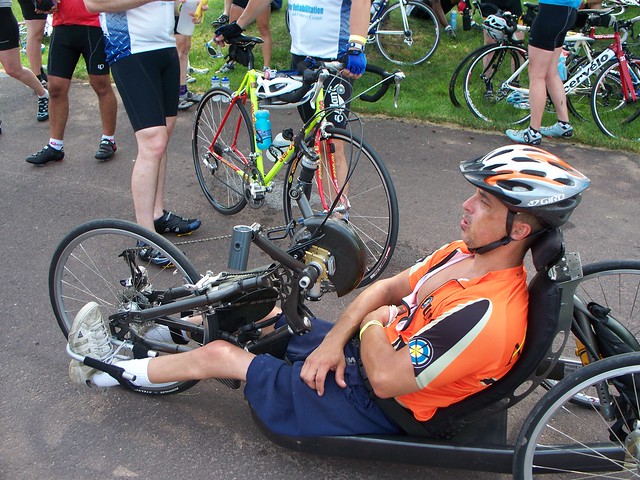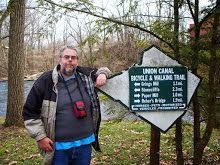Learning to Ride: Pedaling and Your First Bike Ride
If you've followed the advice of the second post in this series, you practiced balancing with the pedals off the bike. You've gotten used to sitting on a bike, your sense of balance improved, and you are ready for the next step.
Put the pedals back on your bike, or have your bike shop do it for you. Take your bike to the secluded area you did last time. If you like, lower the seat to a position that allows you to easily put a foot down. (In the long run this isn't ideal for either your knees or your pedaling efficiency, but if it helps you and doesn't give you pain its OK for a few minutes.) Or keep the seat in the place the shop set it at for you. Whatever makes you comfortable and confident.
The purpose of this series is to lay out a simple approach for an adult to learn to ride. I've purposely skipped a lot of stuff a beginner will need to eventually learn - how to fix a flat tire, how to use the gears, riding in traffic, etc - to focus on the actual act of riding a bicycle. You can learn the rest later. For now lets start riding.
Speaking of starting, here I have to explain why I practice differently than I'm going to advise you. The late
bicycle expert Sheldon Brown wrote extensively on the better way to mount a bicycle. Because I am balance-challenged, I have to balance myself and the bike on the toes of one foot before I push off. See the photo to the right. I agree with Brown that this is inefficient, and I recommend you read his article on starting and stopping. Keep in mind that Brown was a purist on many matters, and I don't think that on a bike there is a "right" and "wrong" so much as good and better. I recommend you follow, if possible, Brown's "Correct Basic Starting Technique" described in the linked article. Click over, read it, and then come back. We'll wait.
Regardless of how you start, start. Those pedals are turning. Congratulations, you are now riding a bike. Now get used to it. The reason we came back to the place you were coasting is because you are probably going to be wobbly and uncertain. My first ride was famously so, as I crashed while trying to avoid a mailbox. I didn't realize that we instinctively steer towards what we look at. And my turning was sloppy. You can do better, and these few minutes riding, getting the feel for the bike, are about your doing better.
As I wrote above, I didn't realize instinct is to steer towards something we look at. Don't make the same mistake. While you are riding, try to keep a straight line. Pick something ahead but not in your direct path - a mark in the pavement, a basketball hoop, a mailbox - to look at while keeping a straight line. Do this a few times until you feel comfortable.
As for turns, as a new bike rider you are going to be wobbly and have wide turns. The wobble will go away and the turns will improve as you gain experience, and speed. Practice will help, but the point of the riding today is to get you familiar with how the bike handles. You are getting a feel for riding. And speaking of which if you lowered the seat before, you can raise it up again during this practice riding. Get used to it at its normal position.
By now you've probably gotten sick of riding around the parking lot. Lets go for a longer ride. But not too long. For your first ride I recommend no more than a mile or two. (A normal slow riding speed is about 8 miles per hour, so two miles would be around a quarter hour or so.) Its OK to do less than that. Its also OK to have your first ride on another day if you like.
When you go for your first ride, I recommend a multi-use path or a quiet street. Remember, your bike is a vehicle, and you should obey traffic rules - don't ride on a sidewalk, ride WITH traffic on the right side of the road, and as far to the right as practicable. I recommend, if possible, riding with a friend, for not only companionship but also in case you have a problem or question.
After your first ride it might become apparent why I suggested you stick with a short distance. You will be sore, and your butt will probably hurt. The soreness comes from using muscles differently than they've been used before. The pain in your butt is getting used to a bike seat. Yes, the internet is full of stories about people who purchased some wonderful bike seat - or, as its often called, a saddle - and rode it pain-free right out of the box. For most people, that isn't true. You might have a sore posterior for a couple of days. While the immediate response is, "I need a new seat", I suggest you stick with the one you have a while. Cyclists often change their saddles in the hope of finding a more comfortable one, but they've also been riding a lot longer than you have. Give it a shot, and see if its more comfortable on the next few rides.
 Ditto for any other soreness you may feel. You and your bike will be adjusting to each other for a long time, but at first the muscles will need to adjust to their new movements and position. If you have actual pain while riding, speak with a bike-riding friend, or your bike shop, about making adjustments. But soreness should go away as you get used to riding.
Ditto for any other soreness you may feel. You and your bike will be adjusting to each other for a long time, but at first the muscles will need to adjust to their new movements and position. If you have actual pain while riding, speak with a bike-riding friend, or your bike shop, about making adjustments. But soreness should go away as you get used to riding.As for your second ride, I suggest waiting a day or two after the first if you feel tired. Give yourself time to recover. Riding too much too soon might exhaust you and give you the idea that cycling, after all, isn't for you. That would be wrong. Riding a bike IS for you, and now you can do it. Welcome to the world on two wheels! How far you go with it, how far the bike takes you, is in your power.
Labels: Bicycling, Learning to Ride



















